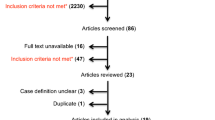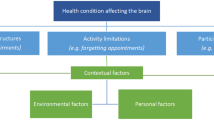Abstract
Return to work following a Traumatic Brain Injury (TBI) is affected by deficits across the cognitive, psycho-social and physical domains. The specific role of cognitive -communicative abilities influencing work re-entry is understudied. This study aimed at identifying the cognitive-communicative predictors for work re-entry following TBI. Thirty patients with TBI employed pre morbidly were categorized into two groups- ‘14’ employed and ‘16’ unemployed post TBI. Those having sustained mild, moderate or severe head injury and in the post injury period of 6–48 months were recruited and majority belonged to skilled/ professional type of premorbid occupational status. They underwent a detailed assessment of cognition, language and communication using NIMHANS Neuropsychology Battery, Indian adapted versions of Western Aphasia Battery and La Trobe Communication Questionnaire (LCQ) respectively. Patients employed post TBI had better Aphasia Quotient (AQ) and better performance on all the cognitive domains and few domains of LCQ than those who remained unemployed. On step-wise Discriminant Function Analysis (DFA), injury severity and AQ could significantly differentiate between the two groups with an overall accuracy of 80%. Severity of head injury is a significant predictor for employability post TBI and evaluation of language along with cognitive abilities is crucial for patients with TBI for work re-entry. The study highlights the importance of a multi-disciplinary team in the assessment and management of cognitive-communication impairments following a TBI.
Similar content being viewed by others
References
Armstrong E. Language disorder: a functional linguistic perspective. Clin Linguist Phon. 2005;19(3):137–53. https://doi.org/10.1080/02699200410001698599.
Blishen BR, Mc Roberts HA. A revised socioeconomic index for occupations in Canada. Can Rev Sociol Anthropol. 1976;13:71–9.
Boeing M, Barton B, Zinsmeister P, Brouwers L, Trudel TM, Elias E, et al. Lifelong living after TBI. Except Parent. 2010;40(10):32.
Brooks N, McKinlay W, Symington C, Beattie A, Campsie L. Return to work within the first seven years of severe head injury. Brain Inj. 1987;1(1):5–19. https://doi.org/10.3109/02699058709034439.
Bryen DN, Potts BB, Carey AC. So you want to work? What employers say about job skills, recruitment and hiring employees who rely on AAC. Augment Altern Commun. 2007;23(2):126–39. https://doi.org/10.1080/07434610600991175.
Cattelani R, Tanzi F, Lombardi F, Mazzucchi A. Competitive re-employment after severe traumatic brain injury: clinical, cognitive and behavioural predictive variables. Brain Inj. 2002;16(1):51–64. https://doi.org/10.1080/02699050110088821.
Coetzer BR, Hayes NM, Du Toit PL. Long-term employment outcomes in a rural area following traumatic brain injury. Aust J Rural Health. 2002;10(4):229–32. https://doi.org/10.1046/j.1440-1584.2002.00425.x.
Dalemans RJ, de Witte LP, Wade DT, van den Heuvel WJ. A description of social participation in working-age persons with aphasia: a review of the literature. Aphasiology. 2008;22:1071–91.
Douglas JM, Bracy CA, Snow PC. Measuring perceived communicative ability after traumatic brain injury: reliability and validity of the La Trobe Communication Questionnaire. J Head Trauma Rehabil. 2007;22(1):31–8.
Draper K, Ponsford J. Cognitive functioning ten years following traumatic brain injury and rehabilitation. Neuropsychology. 2008;22(5):618–25. https://doi.org/10.1037/0894-4105.22.5.618.
Finnanger TG, Skandsen T, Andersson S, Lydersen S, Vik A, Indredavik M. Differentiated patterns of cognitive impairment 12 months after severe and moderate traumatic brain injury. Brain Inj. 2013;27(13–14):1606–16. https://doi.org/10.3109/02699052.2013.831127.
Forslund MV, Arango-Lasprilla JC, Roe C, Perrin PB, Sigurdardottir S, Andelic N. Multi-level modelling of employment probability trajectories and employment stability at 1, 2 and 5 years after traumatic brain injury. Brain Inj. 2014;28(7):980–6. https://doi.org/10.3109/02699052.2014.888770.
Gorgoraptis N, Zaw-Linn J, Feeney C, Tenorio-Jimenez C, Niemi M, Malik A, Ham T, Goldstone AP, Sharp DJ. Cognitive impairment and health-related quality of life following traumatic brain injury. NeuroRehabilitation. 2019;44(3):321–31. https://doi.org/10.3233/NRE-182618.
Isaki E, Turkstra L. Communication abilities and work re-entry following traumatic brain injury. Brain Inj. 2000;14(5):441–53. https://doi.org/10.1080/026990500120547.
Karanth P. Western aphasia battery in Hindi. Mysore: ICMR Project, All India Institute of Speech and Hearing; 1980. https://doi.org/10.1097/00001199-200701000-00004.
Kertesz A. Western aphasia battery test. Harcourt, Brace: The Psychological Corporation; Javanovich Inc; 1982.
Keyser-Marcus LA, Bricout JC, Wehman P, Campbell LR, Cifu DX, Englander J, High W, Zafonte RD. Acute predictors of return to employment after traumatic brain injury: a longitudinal follow-up. Arch Phys Med Rehabil. 2002;83(5):635–41. https://doi.org/10.1053/apmr.2002.31605.
Ludlow CL, Rosenberg J, Fair C, Buck D, Schesselman S, Salazar A. Brain lesions associated with nonfluent aphasia fifteen years following penetrating head injury. Brain J Neurol. 1986;109(Pt 1):55–80. https://doi.org/10.1093/brain/109.1.55.
MacDonald S, Johnson CJ. Assessment of subtle cognitive-communication deficits following acquired brain injury: a normative study of the Functional Assessment of Verbal Reasoning and Executive Strategies (FAVRES). Brain Inj. 2005;19(11):895–902.
Madigan NK, DeLuca J, Diamond BJ, Tramontano G, Averill A. Speed of information processing in traumatic brain injury: modality-specific factors. J Head Trauma Rehabil. 2000;15(3):943–56. https://doi.org/10.1097/00001199-200006000-00007.
Mahar C, Fraser K. Barriers to successful community reintegration following Acquired Brain Injury (ABI). Int J Disabil Manag. 2011;6(1):49–67. https://doi.org/10.3316/informit.648417009019112.
Meulenbroek P, Bowers B, Turkstra LS. Characterizing common workplace communication skills for disorders associated with traumatic brain injury: a qualitative study. J Vocat Rehabil. 2016;44(1):15–31. https://doi.org/10.3233/JVR-150777.
Miller LS, Rohling ML. A statistical interpretive method for neuropsychological test data. Neuropsychol Rev. 2001;11(3):143–69. https://doi.org/10.1023/a:1016602708066.
O’Neil-Pirozzi TM, Lequerica AH, Chiaravalloti ND, Juengst SB, Newman JK. Cognitive-communication predictors of employment outcomes 1 and 5 years posttraumatic brain injury. J Head Trauma Rehabil. 2021;36(3):196–204. https://doi.org/10.1097/HTR.0000000000000641.
Ownsworth T, McKenna K. Investigation of factors related to employment outcome following traumatic brain injury: a critical review and conceptual model. Disabil Rehabil. 2004;26(13):765–83.
Ozbudak Demir S, Görgülü G, Köseoglu F. Comparison of rehabilitation outcome in patients with aphasic and non-aphasic traumatic brain injury. J Rehabil Med. 2006;38(1):68–71. https://doi.org/10.1080/16501970510041262.
Ponsford JL, Olver JH, Curran C, Ng K. Prediction of employment status 2 years after traumatic brain injury. Brain Inj. 1995;9(1):11–20. https://doi.org/10.3109/02699059509004566.
Rao SL, Subbakrishna DK, Gopukumar K. NIMHANS neuropsychology battery. Bangalore: National Institute of Mental Health and Neurosciences; 2004.
Rietdijk R, Simpson G, Togher L, Power E, Gillett L. An exploratory prospective study of the association between communication skills and employment outcomes after severe traumatic brain injury. Brain Inj. 2013;27(7–8):812–8.
Sale P, West M, Sherron P, Wehman PH. Exploratory analysis of job separations from supported employment for persons with traumatic brain injury. J Head Trauma Rehabil. 1991;6(3):1–11.
Schwab K, Grafman J, Salazar AM, Kraft J. Residual impairments and work status 15 years after penetrating head injury: report from the Vietnam Head Injury Study. Neurology. 1993;43(1):95–103. https://doi.org/10.1212/wnl.43.1_part_1.95.
Stergiou-Kita M, Dawson DR, Rappolt SG. An integrated review of the processes and factors relevant to vocational evaluation following traumatic brain injury. J Occup Rehabil. 2011;21(3):374–94. https://doi.org/10.1007/s10926-010-9282-0.
Struchen MA, Clark AN, Sander AM, Mills MR, Evans G, Kurtz D. Relation of executive functioning and social communication measures to functional outcomes following traumatic brain injury. NeuroRehabilitation. 2008;23(2):185–98.
Thornhill S, Teasdale GM, Murray GD, McEwen J, Roy CW, Penny KI. Disability in young people and adults one year after head injury: prospective cohort study. BMJ (clin Res Ed). 2000;320(7250):1631–5. https://doi.org/10.1136/bmj.320.7250.1631.
van Velzen JM, van Bennekom CA, Edelaar MJ, Sluiter JK, Frings-Dresen MH. How many people return to work after acquired brain injury?: A systematic review. Brain Inj. 2009a;23(6):473–88. https://doi.org/10.1080/02699050902970737.
van Velzen JM, van Bennekom CA, Edelaar MJ, Sluiter JK, Frings-Dresen MH. Prognostic factors of return to work after acquired brain injury: a systematic review. Brain Inj. 2009b;23(5):385–95. https://doi.org/10.1080/02699050902838165.
Vas AK, Chapman SB, Cook LG. Language impairments in traumatic brain injury: a window into complex cognitive performance. Handb Clin Neurol. 2015;128:497–510. https://doi.org/10.1016/B978-0-444-63521-1.00031-5.
Acknowledgements
This study was supported by Defence Research & Development Organization -Life Sciences Research Board (DRDO-LSRB), Government of India (Grant reference No.:O/o DG(TM)/81/48222/LSRB-309).
Author information
Authors and Affiliations
Contributions
VPV: conception and design, drafting the article or revising it critically for important intellectual content; JKD: design and acquisition of data, analysis and interpretation of data, drafting the article and revising it critically; MA: design and acquisition of data, analysis and interpretation of data, drafting the article and revising it critically; Dr. Prof. DS: Design, data interpretation, revised the manuscript critically for important intellectual content; Prof. JR: revising the manuscript critically for intellectual content; All authors read and approved the final manuscript.
Corresponding author
Ethics declarations
Conflict of interest
The authors have no relevant financial or non-financial interests to disclose.
Ethical Approval
The study is in compliance with the Declaration of Helsinki and was approved by the Research Ethics Committees of NIMHANS, Bengaluru.
Consent to Participate
Informed consent was obtained from all the participants and their family caregivers.
Additional information
Publisher's Note
Springer Nature remains neutral with regard to jurisdictional claims in published maps and institutional affiliations.
Rights and permissions
About this article
Cite this article
Vandana, V.P., Darshini, J.K., Afsar, M. et al. Getting Back to Work: Cognitive-Communicative Predictors for Work Re-entry Following Traumatic Brain Injury. J. Psychosoc. Rehabil. Ment. Health 10, 25–33 (2023). https://doi.org/10.1007/s40737-022-00286-4
Received:
Accepted:
Published:
Issue Date:
DOI: https://doi.org/10.1007/s40737-022-00286-4




